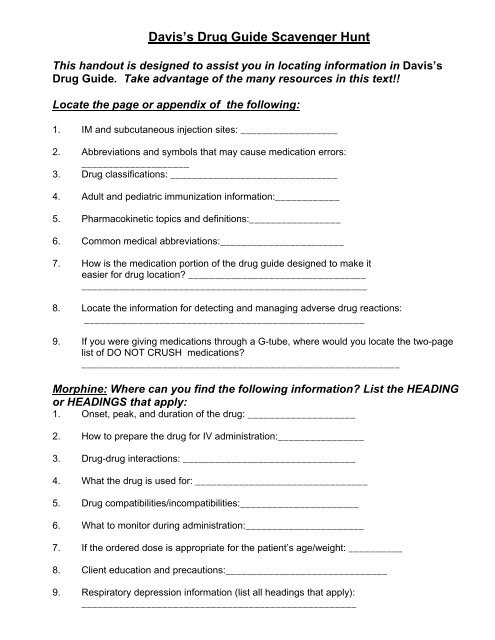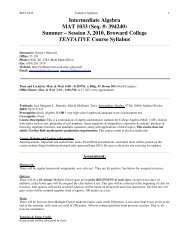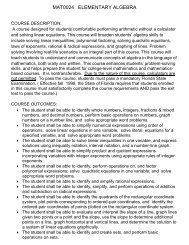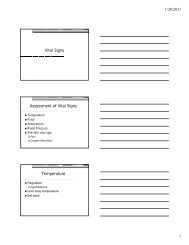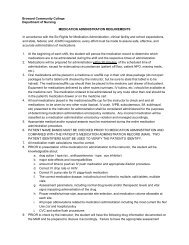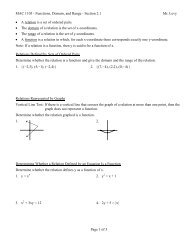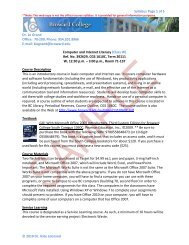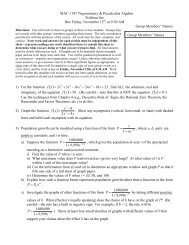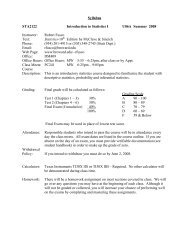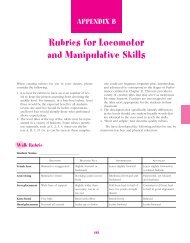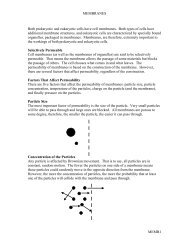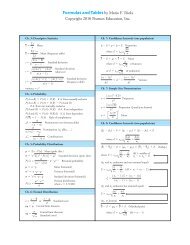Davis's Drug Guide Scavenger Hunt
Davis's Drug Guide Scavenger Hunt
Davis's Drug Guide Scavenger Hunt
Create successful ePaper yourself
Turn your PDF publications into a flip-book with our unique Google optimized e-Paper software.
Davis’s <strong>Drug</strong> <strong>Guide</strong> <strong>Scavenger</strong> <strong>Hunt</strong><br />
This handout is designed to assist you in locating information in Davis’s<br />
<strong>Drug</strong> <strong>Guide</strong>. Take advantage of the many resources in this text!!<br />
Locate the page or appendix of the following:<br />
1. IM and subcutaneous injection sites: __________________<br />
2. Abbreviations and symbols that may cause medication errors:<br />
____________________<br />
3. <strong>Drug</strong> classifications: _______________________________<br />
4. Adult and pediatric immunization information:____________<br />
5. Pharmacokinetic topics and definitions:_________________<br />
6. Common medical abbreviations:_______________________<br />
7. How is the medication portion of the drug guide designed to make it<br />
easier for drug location _________________________________<br />
_____________________________________________________<br />
8. Locate the information for detecting and managing adverse drug reactions:<br />
____________________________________________________<br />
9. If you were giving medications through a G-tube, where would you locate the two-page<br />
list of DO NOT CRUSH medications<br />
___________________________________________________________<br />
Morphine: Where can you find the following information List the HEADING<br />
or HEADINGS that apply:<br />
1. Onset, peak, and duration of the drug: ____________________<br />
2. How to prepare the drug for IV administration:________________<br />
3. <strong>Drug</strong>-drug interactions: ________________________________<br />
4. What the drug is used for: ________________________________<br />
5. <strong>Drug</strong> compatibilities/incompatibilities:______________________<br />
6. What to monitor during administration:______________________<br />
7. If the ordered dose is appropriate for the patient’s age/weight: __________<br />
8. Client education and precautions:______________________________<br />
9. Respiratory depression information (list all headings that apply):<br />
___________________________________________________
(1)<br />
Answer the following questions as they relate to the specific drug listed:<br />
1. Morphine: Direct IV(IV push): How will you dilute this drug to give it IV push<br />
__________________________________________________________________<br />
2. Potassium Chloride: Continuous infusion: What is the dilution requirement for this highalert<br />
medication<br />
___________________________________________________________________<br />
___________________________________________________________________<br />
4. Hydromorphone: Y-site compatibility: List two third-generation cephalosporins that are<br />
Y-site compatible with hydromorphone.<br />
_________________________________________________________________<br />
5. Lorazepam: Direct IV(IV push): What are the specific dilution instructions for<br />
administering this drug direct IV<br />
____________________________________________________________________<br />
____________________________________________________________________<br />
6. Heparin: Bolus (loading dose): How will you administer a loading dose of this drug<br />
____________________________________________________________________<br />
Research the following:<br />
7. Your patient is ordered Solu-Medrol IV 40 mg every morning.<br />
According to Davis’s <strong>Drug</strong> <strong>Guide</strong>, answer the following:<br />
a. Reconstitute with:_________________________________________<br />
b. Your patient is receiving sodium bicarbonate by continuous<br />
infusion. Is the Solu-Medrol Y-site compatible __________________<br />
8. What primary common IV solution CANNOT be used with Dilantin<br />
________________________________________________________________<br />
9. Your medical/surgical patient has been admitted with CHF. The patient has D 5 ½ NSS 20<br />
mEq of KCL infusing at 80 mL/hr. The patient is also receiving Lasix intermittently<br />
(connected to the primary IV) and is currently infusing at 10 mL/hr. The patient is<br />
complaining of nausea/vomiting and is ordered Zofran 4 mg IV. The 4-mg dose can be<br />
given by direct IV (see questions on the next page).
(2)<br />
a. What combination of drugs is going through the same tubing<br />
_____________________________________________<br />
b. Are there any compatibility issues If so, what are they<br />
_____________________________________________<br />
Research for the following drugs in the <strong>Drug</strong> <strong>Guide</strong> to determine compatibility:<br />
Compatible Answer Yes or No to the following combinations of drugs:<br />
(Hint: Look closely at the route.)<br />
1. Morphine IV and lorazepam IV ____________________<br />
2. Insulin regular IV diltiazem IV ____________________<br />
3. Meperidine IM and hydroxyzine IM ____________________<br />
4. Morphine IM and prochlorperazine IM ____________________<br />
5. Potassium chloride IV and cefepime IV ____________________<br />
Name two drugs from Davis’s <strong>Drug</strong> <strong>Guide</strong> that are listed as HIGH ALERT, and explain<br />
why they are classified as such.<br />
6. _______________________________________________________<br />
_______________________________________________________<br />
7. ________________________________________________________<br />
________________________________________________________<br />
Corticosteroids:<br />
1. List the four different routes for this group of drugs:<br />
________________________________________________________<br />
2. If you were giving a corticosteroid by the IV route, which route section would you research<br />
__________________________________________________________<br />
3. If you were giving Flovent, in which route section would this be found<br />
__________________________________________________________<br />
(3)
Insulins:<br />
1. What is the only type of insulin that may be given by the IV route<br />
____________________________________________________________<br />
2. List three insulins that may be mixed with NPH insulin in the same syringe.<br />
____________________________________________________________<br />
3. When mixing NPH and regular insulins, which one is withdrawn into the syringe first<br />
____________________________________________________________<br />
4. What two insulins make up Humulin 70/30<br />
_____________________________________________________________<br />
5. Why would you NOT use insulin detemir (Levemir) for a sliding-scale or coverage insulin<br />
_____________________________________________________________<br />
Miscellaneous:<br />
1. What is the only subcutaneous site for Lovenox (enoxaparin)<br />
_____________________________________________________________<br />
2. When giving morphine or Dilaudid (hydromorphone) by direct IV, what is the common<br />
diluent instructions with these two medications<br />
________________________________________________________________<br />
3. When administering Protonix (pantoprazole) by direct IV:<br />
a. How is it reconstituted ________________________________________<br />
b. What is the administration rate__________________________________<br />
4. List one morphine oral suspension drug.____________________________<br />
5. What is the most common GI side effect of narcotics _________________<br />
6. Your patient has been admitted with liver cancer and has a large amount of abdominal<br />
ascites. Due to this, he is to receive albumin (human) for hypoproteinemia.<br />
a. What albumin % solution would you expect the doctor to order<br />
_____________________________________________<br />
b. What should the IV infusion rate be of this albumin<br />
___________________________________________
(4)<br />
c. Why shouldn’t albumin be mixed in sterile water<br />
_____________________________________________<br />
Antihypertensives:<br />
1. You are giving your patient atenolol for hypertension this morning. Patient’s blood pressure<br />
is 134/75.<br />
a. What other vital sign must be measured before administering beta blockers<br />
_______________________________________________________<br />
b. What is the beta-blocker parameter for this vital sign ________________<br />
2. Cardizem LA is a calcium channel blocker. You are to administer 90 mg once daily.<br />
a. What does LA mean____________________________________<br />
b. This patient has difficulty swallowing. Can this pill be crushed If not, why<br />
_____________________________________________________________<br />
3. A patient is ordered Diovan (valsartan). What is the pharmacologic class of this<br />
drug______________________________________________________<br />
a. Why is it important to monitor the patient’s daily weight with this drug<br />
_____________________________________________________<br />
b. What lab values should be monitored with this drug<br />
______________________________________________________<br />
Davis’s drug guide scavenger hunt 2012<br />
(5)


